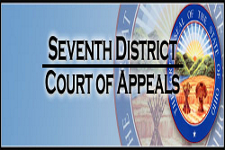In February of 2011, Thurman Trowbridge was working as a security guard at Franciscan University when he slipped while coming off of a step. He struck his head on the step, fracturing two vertebrae as well as sustaining other significant injuries. The area had recently been mopped, and Mr. Trowbridge claims not to have seen any posted signs indicating that the area was wet. He further indicated that he knew the area was shiny but was unsure whether it was wet.
**The Lawsuit at the Trial Court Level**
Mr. Trowbridge [filed an action](https://www.supremecourt.ohio.gov/rod/docs/pdf/7/2013/2013-ohio-5770.pdf) against the University for his injuries. The University filed a motion for summary judgment, which was granted by the trial court on the grounds that Mr. Trowbridge “assumed the risk” of slipping and falling.
**The Lawsuit at the Seventh District Court of Appeals**
Mr. Trowbridge appealed the decision of the trial court to the Seventh District. He argued that the dangerous condition was not “open and obvious” because it was unclear whether the floor was actually wet or was just glossy from being waxed. Mr. Trowbridge further argued that even if he assumed an amount of risk, summary judgment was inappropriate because a jury should decide the comparative fault of the University.
**The Applicable Law**
The action here was one based on a theory of negligence. Negligence has four elements: duty, breach, causation, and damages. As to duty, a premises owner in Ohio (here, the University) has a general duty to exercise ordinary care in maintaining the premises in a [reasonably safe condition](http://statecasefiles.justia.com/documents/ohio/seventh-district-court-of-appeals/2007-ohio-4997.pdf). This generally means that the owner must not create a dangerous condition and must warn of latent or concealed dangers. However, business invitees (here, Mr. Trowbridge) are expected to take their own reasonable precautions against injury, to avoid dangers that are “open and obvious.” A business owner has no duty to warn against dangers that are open and obvious. Notably, it is not critical that a plaintiff actually observe the danger, the question is whether the condition is, under an objective standard, observable.
Assumption of risk is a defense to a negligence action. This is defined as a plaintiff’s consent to or acquiescence in an appreciated, known, or obvious risk to safety. It requires full knowledge of a condition that is patently dangerous, as well as voluntary exposure to the hazard (**See Briere v. Lathrop Co., 22 Ohio St.2d 166, 174-175, 268 N.E.2d 597 (1970)**). Assumption of risk is related to a defense of comparative negligence, which is generally a question of fact determined by a trier of fact (See [Brady-Fray v. Toledo Edison Co., 6th Dist. No. L-02-1260, 2003-Ohio-3422](http://statecasefiles.justia.com/documents/ohio/sixth-district-court-of-appeals/2003-ohio-3422.pdf)).
**The Decision**
Mr. Trowbridge argued to the Appellate Court that the open and obvious doctrine was not a bar to his action because there were disputed facts as to whether it was objectively obvious that the area was actually wet. The Court agreed, holding that there was no definitive testimony/evidence that the shiny appearance of the floor objectively indicated open and obvious danger.
Mr. Trowbridge also argued that even if he assumed some of the risk of danger, a jury question still existed as to the comparative fault of the University. The Appellate Court agreed, holding that implied assumption of risk is usually left for the trier of fact to decide, and that there were genuine issues of material fact in dispute abut the comparative negligence of the parties in the case.
This case represents a good win for the Plaintiff’s bar. It can be relied upon in a number of typical fact patterns found in slip and fall cases.
-Written by Andrew Tobergte

